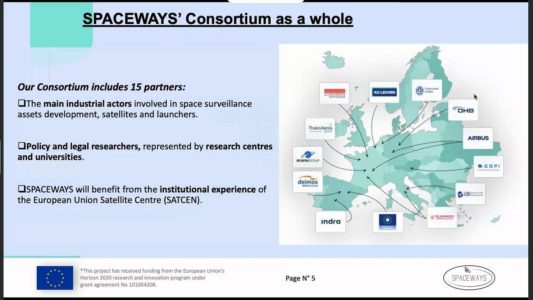
24 European entities provided their views on the status of Space Traffic Management (STM) and its ways forward
SPACEWAYS* received funding under the Horizon 2020 Framework Programme. Its objective is to provide recommendations and guidelines to the European Commission on STM, by analysing European capabilities, technology gaps and provide legal, policy and economic assessments. To ensure the study outputs are embraced by the whole European space community, external stakeholders are actively involved within a Stakeholder Engagement Programme. In May 2021, three virtual workshops were organised as part of this Stakeholders Engagement Programme, to gather views and needs on STM from institutional, operators and R&D actors.
More than 100 participants from these 24 organisations took part in the three workshops, including institutional actors (national agencies, Ministries of Defence (MoDs), intergovernmental organisations, and EU institutions), public and private satellites operators, Space Surveillance and Tracking (SST) service providers, and R&D related entities (SME, start-ups, and non-profit organisations).
The events were organised to tackle the status of STM and possible ways forward from different perspectives, and to identify the needs of each stakeholder group. There was a common agreement on the fact that space is becoming more congested and more unpredictable, which leads to an increase in collision risks in space. Most stakeholders considered that we are already at (or even past) a critical point vis-à-vis space sustainability, safety, and security.
STM is a global issue, and as such a holistic approach was encouraged. A global regulatory framework was viewed as ideal, however a couple of constraints were identified: (1) at UN level, only soft law seems to be envisioned (2) the establishment of a European Space Programme excludes the harmonization of space laws and regulations between EU member states[1]. In this regard, a variety of potential paths were provided, along with suggestions on enforcement, incentives, and best practices implementation.
STM was also defined as an international, multidisciplinary, and multi-stakeholder concern and there was a major consensus to involve all actors related to STM since the onset of the conversations.
The current status on STM was identified as an opportunity for the European Union, highlighting its technical and operational capabilities and expertise, as well as its unique capacity to federate national and European resources, as well as its already operational space traffic system (EU SST). However, it was noted that the European Union needs to move coordinated and fast to overcome its main gaps, most notably the need for a common and coordinated European position, the lack of autonomy on space surveillance information, and the required budget to achieve the necessary level of autonomy.
With the objective of balancing short-term operational needs and long-term international consensus, stakeholders favoured simultaneous bottom-up and top-down approaches, and reflected the importance of standardisation in the convergence process.
Finally, from discussions on automation and artificial intelligence possibilities arose safety concerns related to robustness, reliability, explainability, and rules transparency, leading to suggesting the progressive implementation of such technical solutions.
What’s next? Further rounds of workshops are scheduled during the project and will serve to present the progress made, collect feedback and proposed orientations for the next phases.
Interested in following the latest news and information about SPACEWAYS? Visit our website, and join us on Twitter, LinkedIn and Youtube.
*SPACEWAYS project has received funding from the European Union’s Horizon 2020 research and innovation programme under grant agreement No 101004208. The information and views set out in this document are those of the authors. The European Commission and the European Health and Digital Executive Agency are not responsible for any use that may be made of the information it contains. Click here to access the list of SPACEWAYS Consortium members.
[1] Treaty on the Functioning of the European Union, Article 189 §2, https://eur-lex.europa.eu/legal-content/EN/TXT/?uri=celex%3A12012E%2FTXT




1 comment
Comments are closed.